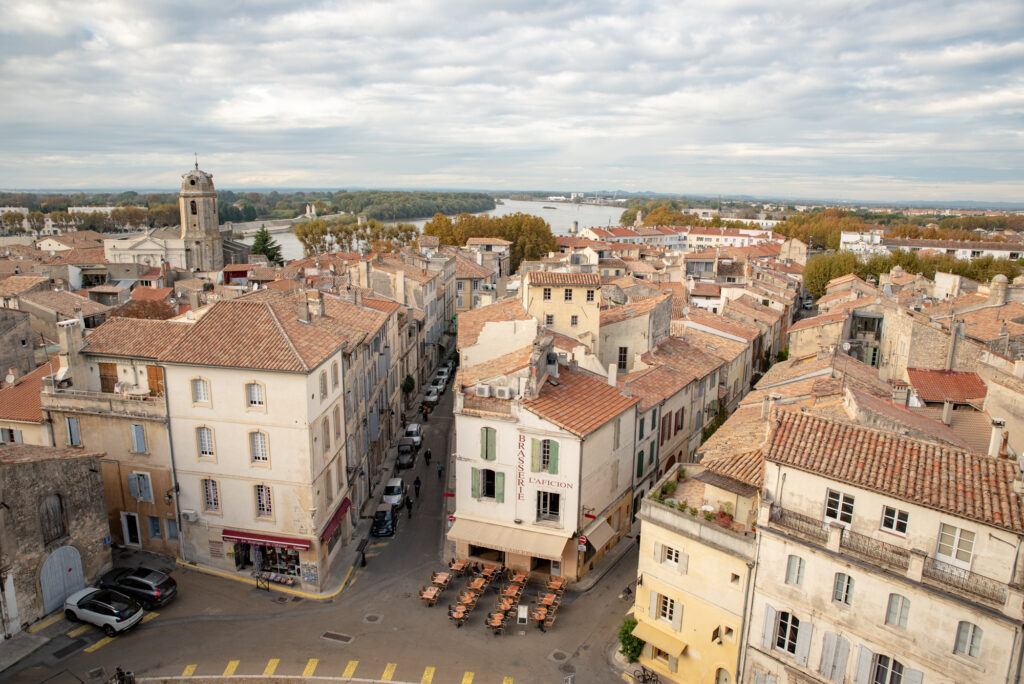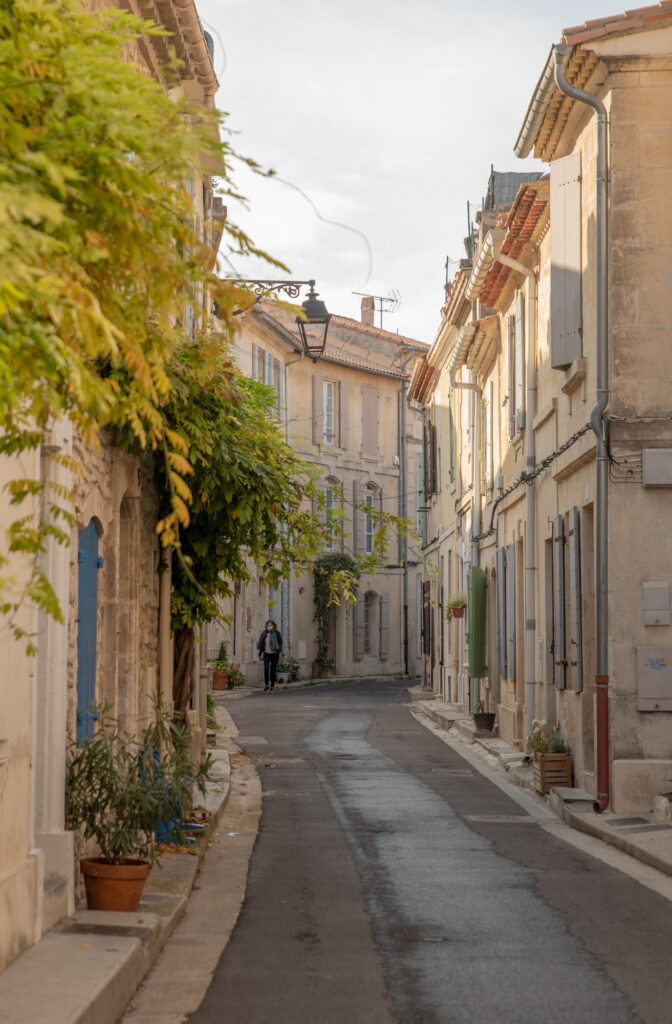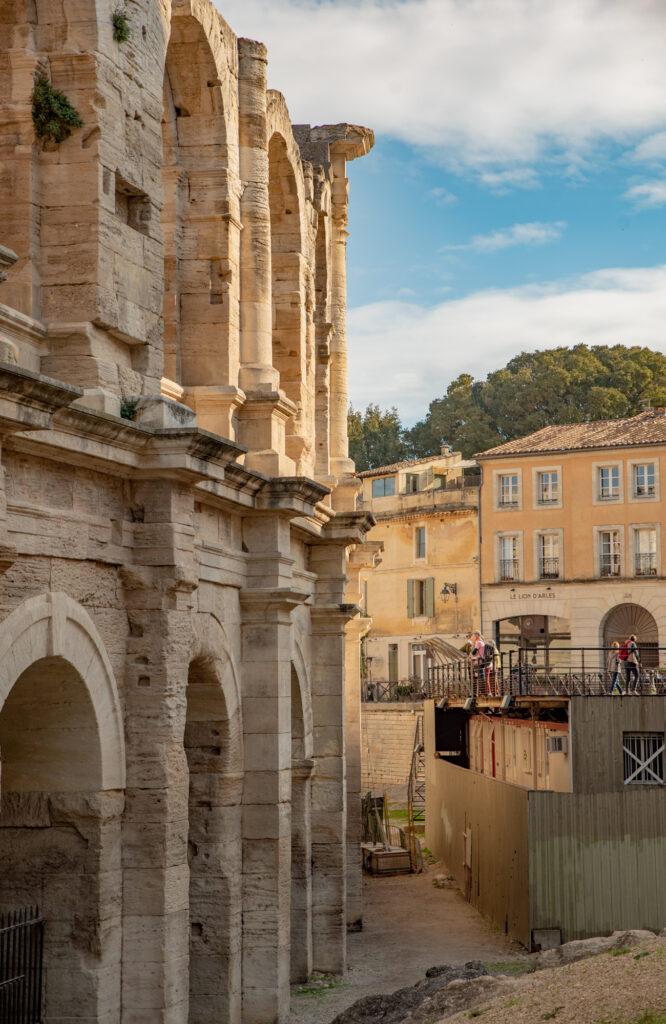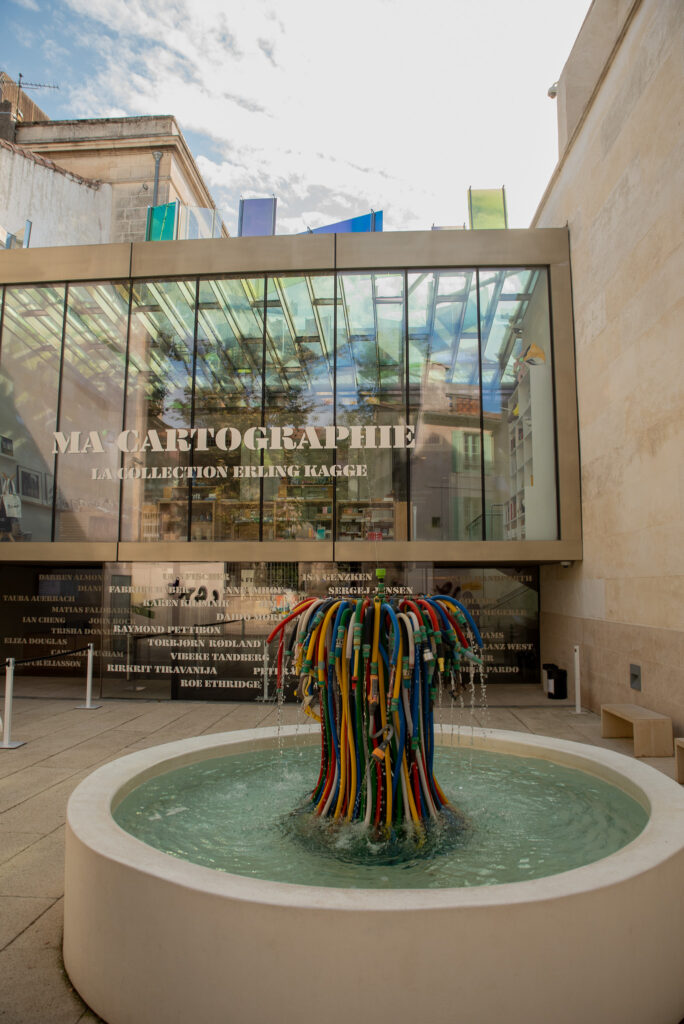A Local’s Guide to Arles, France | Art & Archaeology in Provence
Arles, on the banks of the Rhône River, could easily be described as a city with one foot in the past, and another in the present.
You can while away mornings touring the Roman baths, ancient theatres and the beautifully preserved 1st-century arena, then head for LUMA Arles to see the modern, glittering stainless steel tower designed by Frank Gehry in the afternoon.
Enjoy picnics in verdant parks and take leisurely walks by the river, before discovering the streets and city locations where Vincent Van Gogh was inspired to create his greatest works of art.
Wander along ancient trails and browse open-air produce markets before settling in a seat beneath shady plane trees to sip coffee and munch on buttery pastries.

For those also keen to discover the surrounding areas, Arles’ central location allows easy access to Avignon, Marseille and the breathtaking Camargue Regional National Park – you couldn’t ask for much more in a holiday destination!
Related Reading: Best Places to Stay in Provence, France
A Brief History of Arles
The ancient Greeks arrived in Provence in the 6th century B.C., founding Arles and naming it Theline. However, it wasn’t until centuries later when the Romans took over, that the town really began to thrive.
Under Caesar’s command, the Romans transformed the town (known now as Arelate) into a commerce and trading hotspot. This allowed them to construct spectacular arenas, theatres and public baths, partly for their citizens’ social enjoyment, and partly to demonstrate their wealth and dominion to would-be invaders.


When the Empire fell, the Visigoths and others arrived, but their residence was short-lived, as during the Renaissance era, Arles became known as a hub for culture and art. The city still retains the moniker to this day, attracting some of the world’s finest artists, thinkers and designers.
Getting to Arles
Getting to Arles is easy if you’re hiring a car. From Marseille (and the Marseille Provence airport) to the southeast, there are two main routes – along the A7 or the A55 autoroutes on either side of the Étang lake. The drive will take you around an hour from the airport, and a little longer from the city.
If you’re arriving by car from Avignon, drive south along the D570N or D2, and if your point of origin is Nimes (or the Nîmes airport) the A54 leads directly to Arles.

You can also travel to Arles by rail. The city’s train station is at Av. Paulin Talabot just outside the centre. Direct trains frequently arrive in Arles from Avignon, Marseille, Montpellier and Nîmes. A free shuttle bus also transports you from the train station into the city centre (during the day).


Next to the train station, Gare Routière bus stop has services to the pretty towns of Saint-Remy (704 and 707) and Saintes-Marie-de-la-Mer (A50) for the Parc Naturel Regional de Camargue.
Best Things to do in Arles
If you’re wondering what to see in Arles during your stay or day trip, you’re spoilt for choice! Below you’ll find a list of my favourite attractions and activities to add to your itinerary.
Visit the Arles Roman Amphitheatre

In a city bursting with show-stopping attractions, a highlight has to be the magnificent Roman Amphitheatre in the centre of town. A heritage site of great magnitude, this well-preserved arena was inspired by the Colosseum and is more impressive in real life than in many photographs.


On a tour, you can discover huge sandstone arches, galleries, hidden passageways and staircases. Stand in the arena, gazing up at the tiered seating that once held 20,000 people, and imagine a time when the amphitheatre was packed with cheering spectators, as gladiator battles, theatre performances and chariot races took place.
Learn about a time when the amphitheatre gave shelter to citizens as the Empire fell, and snap incredible photos of the pastel-shuttered houses and rooftops of Arles, and Rhône River, from the upper arches.
Step Back in Time at the Roman Theatre

When the outdoor Théâtre Antique d’Arles was built (shortly before the arena), it held several thousand spectators and was used to entertain the masses with political comedies, dramatic performances and pantomimes on warm summer nights.
During its heyday, it comprised 33 rows of staggered steps overlooking an elaborate stage and orchestra pit. But after the fall of the Empire, the stones were pillaged – earmarked to build new landmarks in the city – an attempt by new conquerors to rewrite history.
Sadly, all that remains today are two Corinthian columns, a few hundred seats and a partial stage.


Visit these Roman ruins in Arles to discover their storied history, learn about Venus of Arles – a marble statue that was discovered here and now lives in the Louvre in Paris – or to watch seasonal plays and concerts. You can purchase a combined ticket when you visit the ampitheatre.
See the Cloister of Saint-Trophime

The medieval Cloître St-Trophime is a sight to behold and a popular starting point for pilgrims beginning their journey along the Via Tolosana to Rome or Santiago de Compostela.
You can see the serene spaces where monks once read their scriptures, and the small garden areas they tended. Admire intricate carvings and reliefs depicting biblical and mythical scenes and spend time in contemplation, beneath the cloisters and away from the bustle of the city.

Afterwards, head for St. Trophime Church in Place de la République. The storied square is home to a 20-metre high, 4th-century obelisk built on the original Roman circus site. The church itself offers great insight into Romanesque architecture with some fine sculptures on the portal, including one of The Last Judgement.
Walk Through The Alyscamps Necropolis

Follow the path along the Via Tolosana leaving the city and you’ll pass the ancient burial ground of The Alyscans. The peaceful spot is located along a section of the walking trail next to the river.
The Alyscans was the Provençal name for Elysian Fields, a hallowed resting place for heroic souls, as depicted in Greek mythology. The site was, in fact, a prized resting place for the Romans, with the deceased often being transported here by boat along the Rhône.
The necropolis is lined with shady trees, and beneath them, marble tombs punctuate the route leaving Arles. Documents show that in later years, the site became a burial ground for a Christian church and some of the souls resting here include Caesarius, a former bishop of Arles from the 6th century and several thousand Frankish warriors who fought in Charlemagne’s military campaigns.
Marvel at the Thermal Baths of Constantine

The Baths of Constantine were built around the 4th century A.D. to form part of an imperial palace in Arles. Nestled on the banks of the Rhône, they are some of the best-preserved Roman bath sites in France!
Although only a portion of the baths are currently visible due to restorative works being undertaken, you can still see the caldarium, a centrepiece of three baths that were heated by a state-of-the-art hypocaust system back in the day. The hypocaust was a kind of underfloor heating system, which – thanks to a series of pipes – passed hot air into the bathing areas to warm the water.


On an informative tour, learn about Roman bathing practices, see where locals came to socialise and relax, and marvel at the preserved stone architecture of this stunning site in Arles.
Discover Van Gogh’s Iconic Painting Locations


If you’re only planning to spend one day in Arles, schedule some time to walk the self-guided Van Gogh trail. While following the route, keep an eye out for the 12 canvasses dotted throughout the city. You’ll discover the places where the great artist set down his easel and painted memorable works like Sunflowers and Starry Night Over the Rhône. Alternatively, download this walking tour to guide you through the city.
A few places not to miss on a tour include Fondation Vincent Van Gogh. The gallery celebrates the work of the artist with temporary exhibitions held throughout the year, showcasing a handful of Van Gogh’s finest (and rarest) works loaned from other museums or private collectors.

You can also visit L’espace Van Gogh at Place du Docteur Felix Rey, set inside a 16th-century former hospital building. This was the initial location where the artist was treated when he cut off his ear in Arles in December 1888. The courtyard of the building has been meticulously designed to recreate the artist’s famous painting ‘Le Jardin de l’Hotel de Dieu’ and the complex houses a café and gift shops.
If you’re still keen to see more of his inspirational landscapes, Van Gogh painted masterpieces at Place Lamartine (the former site of the Yellow House), at picture-postcard Jardin d’Ete, and at Café Van Gogh (Café La Nuit) on Place du Forum where he often drank absinthe with fellow artist Paul Gauguin while sketching.
Browse the Markets

There’s no better way to experience the true essence of Provence than while visiting a local market. The Arles market is held twice weekly (Wed/Sat), and the weekend gathering is the largest in the local area. Here, you can shop for Provençal delights ranging from cheeses and olives to soap, paintings, ceramics, linen clothing and freshly plucked lavender (in the summer months).
Find a café with outdoor seating beneath a plane tree and soak up the ambience while people-watching. If you enjoy browsing for collectables, including books and antiques, you can also visit the flea market on Boulevard des Lices on the first Wednesday of the month.
Explore LUMA Arles

If you’re a fan of art in all of its formats from photography and design, to documentaries and multimedia, pop the LUMA Arles cultural complex on your itinerary. It was built to attract trailblazing creatives who wish to view art from a different perspective.
The extensive, Maja Hoffman helmed private art project, is located at Parc des Ateliers – a former SNCF railroad site – where 19th century industrial factories converge with landscaped gardens and walking trails featuring sculptures and installations.
A highlight is The Tower, a 15,000 square metre, 10-storey high, shimmering stainless steel, Jenga-like addition enclosed with exhibition halls and research rooms designed by architectural luminary Frank Gehry.
The complex also includes expansive exhibition spaces showcasing contemporary artworks, a library, an auditorium and a café.
An Underground Tour of the Cryptoportiques

Hidden below ground, the Cryptoportiques of Arles were the foundation of the city’s Roman Forum. The subterranean gallery dates to 46 B.C. and is said to have housed a series of shops, storage spaces and cellars beneath it. However, some scholars have pointed out that the damp chambers may not have been suitable for storage and may instead have had a darker use, as a holding area for slaves.
You can descend via the stairs and slowly wander through the dark stone chambers and along ancient corridors. It may be a lesser-known city landmark but it’s one of the most intriguing and will leave you wanting to find out more about its secret past…
Go Museum Hopping in Arles

On the scenic banks of the Rhône, ivy-clad Musée Réattu is dedicated to the works of Jacques Réattu, a renowned local painter and Grand Prix de Rome winner, famous for his works completed during the French Revolution. Throughout the years the gallery has played host to sculptures, installations and contemporary paintings by Richier and Picasso, and it was the first museum to show a photography collection in the 1960s.
If you enjoy learning about antiques and relics, Musée Départemental Arles Antique showcases a fabulous collection of Roman artefacts excavated in the city and surrounding areas. A highlight is the Roman barge used for river trade during the Empire. It was discovered just over a decade ago and is said to be the best-preserved of its kind. You can also see ceramics, tools and jewellery from the Neolithic era.
Attend a Local Festival

Every year in Arles, local festivals take place celebrating the city’s rich heritage. If you’re a fan of all things photography, join locals at Les Rencontres d’Arles Photographie, a lively festival dating back to the early 1970s. It runs between July and late September showcasing new perspectives in lens-related art.
Discover the Feria de Riz, a local rice harvest festival. For many centuries the marshlands and salt flats of the Camargue region have allowed red rice to flourish, and during this fun festival, many restaurants in the area prepare dishes so that visitors and locals can taste its unique flavour. Expect to find plates of risotto and skillets of paella on many restaurant menus. The event usually takes place in September and involves colourful parades and concerts.
If it’s music you seek, The Suds takes place in July at various locations across Arles. From arcades to shady squares, ancient theatres or a riverside enclave, you can see music performed by a whole host of renowned global artists.
Related Reading: Your Guide to French Festivals
Other Things to do Around Arles
As I mentioned earlier, Arles makes a great base to explore the western side of Provence, and venture further into the Languedoc. Here are a few of the interesting day trips you can take around Arles.
The Camargue

The Camargue Regional Nature Park is blissfully romantic. A place where windswept beaches, wetlands and salt marshes converge next to the Mediterranean Sea. One of the most popular day trips from Arles, you can see Camargue white horses, wild bulls and flamingos wading in the water as you wander or cycle the trails.


Spend time on the beach partaking in water activities or visit the charming towns of Sainte-Maries-de-la-Mer or Aigues Mortes. To see flamingos in their hundreds, head along to Parc Ornithologique de Pont de Gau – an area of organized marshland where wild flamingos flock to feed, mate and rest.
Avignon

Just 20 minutes from Arles by train is resplendent Avignon, the former home of the Papal residency. On a day out, discover the majestic architecture of the alabaster stone Papal palace, admire the artisan craftsmanship of Notre-Dame-des-Doms cathedral, walk along the half-remaining Saint-Bénézet bridge or find a quaint café and soak up the atmosphere over coffee.


Avignon plays host to the annual Festival d’Avignon, which takes place every July and showcases artistic talent from around the country. Alongside, the fringe festival, Festival Off, also takes place – ideal for families and those just wanting to soak in the jubilant atmosphere.
Pont du Gard

This ancient aqueduct is one of the finest displays of Roman engineering in Europe. It stands almost 50 metres high and has an unusual, triple archway design that spans the River Gardon.

On summer evenings, an incredible sound and light show takes place at the Pont du Gard, when the aqueduct is transformed into a 260-metre-long screen projected with magical visuals synced to a lilting musical soundtrack. Entrance is free during this event, but you will pay for parking.
Saint-Rémy-de-Provence

A short drive from Arles, St-Rémy-de-Provence is another former Roman settlement with several archaeological sites to visit. Arrive on Wednesday to peruse the local market (one of the best & busiest in the region) or continue your Van Gogh discovery on a walking tour.


The old town has elegant boutiques selling everything from clothes and ceramics to chocolates and cheeses. You can also visit the Museum of the Alpilles to learn more about life in the local area, or the Monastery of Saint-Paul de Mausole where Van Gogh was hospitalized for a period.
Nearby, the archaeological site of Glanum is worthy of a half-day exploration too. Here, you can explore the Provence of old, while marveling at Roman feats of engineering!
Where to Stay in Arles
Choosing to stay in Arles is an excellent choice as part of your tour of the South of France. Here are some of our hotel recommendations for Arles.
L’Hôtel Particulier is a beautiful boutique property set in an 18th century residence. This 5 star hotel boasts a central location, an outdoor pool, and luxurious decor.
Maison Volver offers a more contemporary option at the edge of the old town. The family-friendly hotel has rooms and suites to cater to a range of holiday-makers, and everyone will agree that the breakfast spread is superb!
Those seeking more of a “home away from home” vibe will appreciate the apartments at La Bastido. Situated a short & scenic stroll from the city, they’re also a budget-friendly place to stay in Arles.
From cherished artworks and well-preserved Roman architecture to lush parks and bustling markets, Arles has a little of everything to tempt travellers into staying a while. It’s a place to connect with history, art and nature, with fine gastronomy, riverside walks and lively cultural events, plus, it’s easily accessible from most towns and cities in Provence.






